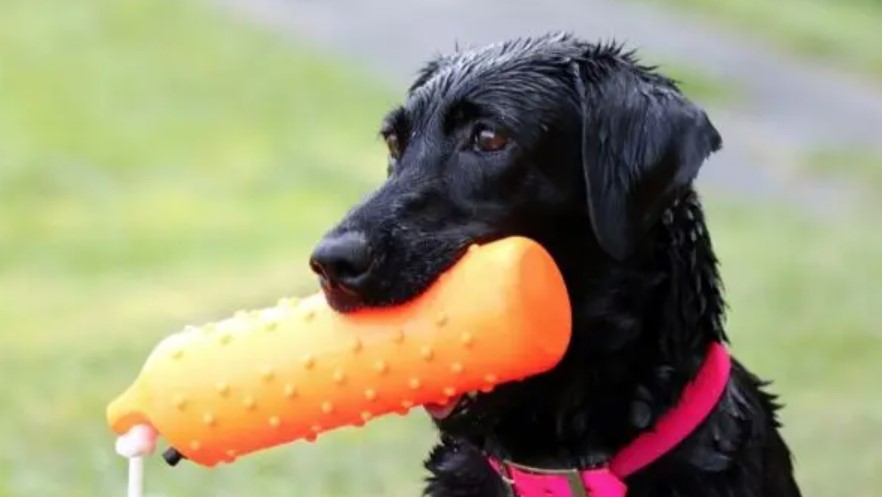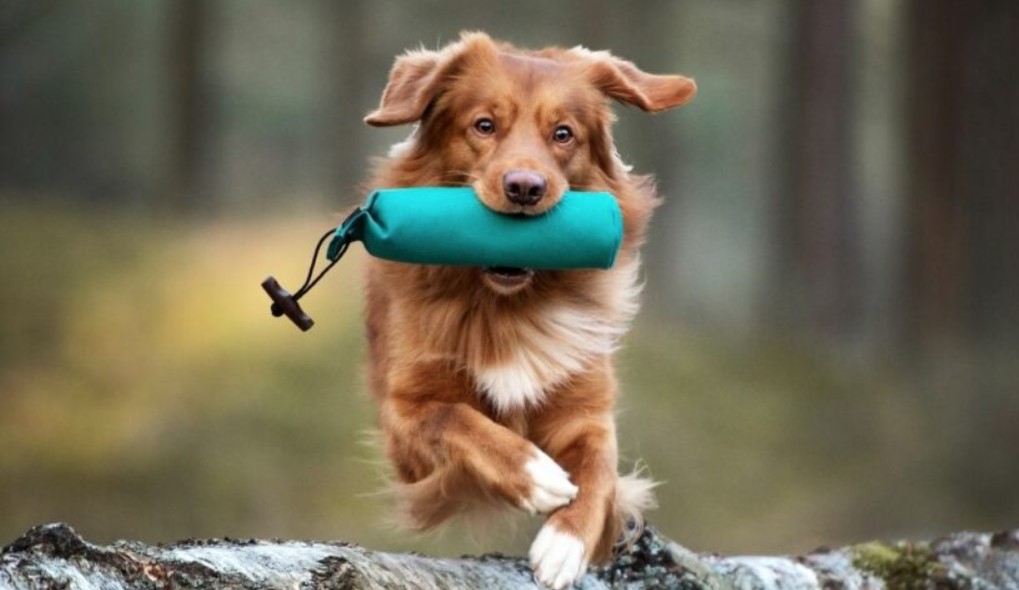Originally from Great Britain, dummy training was invented to train hunting dogs. In the meantime, however, the retrieval of a dummy is also used as a dog sport for the utilization and promotion of leisure and family dogs. Doing this training together can strengthen the dog-human bond and help create physical and mental workloads.
What is dummy training?

The most important tool in dummy training is the dummy. This should be tracked down and fetched by the dog, whereby there are different ways of carrying out the dummy training. For many four-legged friends, especially for dog breeds with an innate hunting instinct, fetching is a welcome activity that, in addition to important exercises for basic obedience, also involves a lot of fun.
How does dummy training work?
The dummy is thrown by the handler or a helper or hidden in the open area and is then to be tracked down and fetched by the dog after a start command from the handler. What initially sounds quite simple demands a lot from the dog and can therefore contribute to its physical and mental workload. Especially large, active dogs can be kept busy in a simple but effective way.
What does dummy training do for dogs?
Physical exertion
The movement in which the dog finds itself while looking for the dummy in the open area puts physical strain on it. Depending on the nature of the respective terrain, this utilization can of course vary. Hills or undergrowth that have to be crossed require the dog’s physical dexterity and are physically more strenuous than flat and clear terrain.
Mental workload
In addition to the physical exertion of the dog, as a dog owner you should not underestimate the mental challenges of dummy training and keep an eye on the respective training duration. The dog must concentrate on the correct execution of the commands addressed to him, with impulse control being particularly important. The use of its strong sense of smell also demands a lot from the dog, as does the concentrated cooperation with the dog handler.
What is dummy training?
During dummy training, a hidden or thrown dummy is fetched by the dog using its senses.
Which dogs are suitable for dummy training?

Which dog breeds are particularly suitable?
Dog breeds with a natural hunting instinct are particularly suitable for retrieval training with a dummy, as they usually get involved in the dummy search quickly and of their own accord. Retriever breeds in particular, such as Labradors or Golden Retrievers, usually have a lot of fun and talent in dummy training. Pointing dogs such as the German Shorthaired Pointer or the German Wirehaired Pointer are also well suited. In principle, however, dummy training can be learned with every breed. It is important to find the right motivation for the respective dog and to always make sure that the dog is only challenged according to its required workload and its level of training and never to overtax it.
When can you start with dummy training?
Dummy training can be introduced to young dogs in a playful way, in order to lay the foundations for later. So there is no perfect starting age. With young dogs, however, there should only be short units so that they are not overwhelmed and lose the fun of dummy training early on. In addition, around the sixth month of life, training may have to be suspended for a while, since dogs are changing teeth at this age and carrying the dummy can cause pain.
What basic commands does the dog need to know?
Good basic obedience and mastering a few commands are the prerequisites for a successful start to training. Your dog should already be readily available in advance, generally concentrate well on you and orientate itself towards you and not be easily distracted by its environment. The command “Stay” should also have been well trained, since your dog should not run as soon as you throw the dummy, but has to wait calmly for your search command before it can go on the path.
When do you start with dummy training?
The playful introduction can begin as early as puppy age. However, it should be noted that puppies can only concentrate for a very short time and should not be overwhelmed.
What do I have to fulfill as a dog owner?
Do I have to be physically fit?
Basically, as a dog owner, you don’t have to be overly sporty when training a dummy. Depending on the difficulty of the terrain, you may have to help your dog find the dummy or, in an emergency, repeat the dummy yourself. This can lead to overcoming obstacles, for which a certain level of basic fitness may certainly be an advantage. Otherwise, however, in contrast to other dog sports, dummy training is also suitable for less sporty dog owners, since the dog does the physical work.
What should the bond with the dog be like?
The bond between dog and owner should be fundamentally established before the start of dummy training, so that there is a relationship of trust and the dog concentrates well and willingly on its owner. Training with the dummy is a collaboration between dog and owner, which is why it is well suited to further strengthen the existing bond. Shared experiences of success weld together and the precise obedience of the dog as well as mutual trust in each other are strengthened. Your binding does not have to be perfect to start training, but if you don’t know each other yet, the binding should first be built up in other ways so that dummy training is promising and fun for both parties.
Tips to get you started: This is how your dog learns dummy training
With the right equipment, motivation and fun, you can start dummy training without the support of a professional trainer or club. Various literature on the Internet or from specialist shops can provide initial tips and approaches, so that every interested dog owner can successfully teach himself the basis of dummy training. If there are problems communicating with the dog, this can lead to frustration.
In order not to spoil your relationship with your dog or the fun of dummy training in such a case, it can be helpful and advisable to consult a professional. He may see finer nuances that need to be changed in order to overcome existing problems in training and to bring the joy of sport back to both dog and owner. In addition, it is certainly an individual preference whether you would rather learn under external guidance or whether you have the necessary patience and desire to deal with dummy training on your own.
Which dogs are suitable for dummy training?

In principle, all dog breeds are suitable for dummy training. However, retrievers and hunting dogs show particular talent here.
Disciplines and exercises in dummy training
The dummy training consists of different areas, namely marking, searching and instructing. In addition, there are various smaller skills that can be learned in the course of the training in order to perfect the dummy training.
For beginners
The disciplines of searching and marking are suitable as an introduction for beginners. When marking, the dog should follow (mark) the trajectory of the dummy with its eyes in order to find its way to the dummy after the search command has been given. This can be practiced on level ground at first. For this purpose, the dummy should be thrown in the highest possible arc so that the dog can see the trajectory clearly. When searching, the dummy is placed in a free but delimited area and is then to be tracked down by the dog with the help of its sense of smell. As a beginner, the commands “search”, “stay” and “retrieve” should also be practiced, as well as handing over the found dummy to the dog owner’s hand. If these processes are on easy terrain, the difficulty can be gradually increased by choosing more confusing terrain or by placing the dummy further away.
For advanced
Instruction tends to belong more in advanced training plans, since various commands have to be learned that are not used in everyday life and therefore have to be thoroughly practiced in advance. The instruction is used when the dog cannot locate the dummy in difficult terrain. In this case, he receives instructions from the handler, who knows the location of the dummy, to support him. To do this, the dog must be able to interpret various signals and whistles that give it directions and instructions and navigate it to the dummy.
Requirements for the perfect start: equipment and terrain
The right dummy
There are now a large number of different dummies on the market. These differ in material, size, weight and whether it is a lined dummy or a food dummy that can be filled with treats. The selection of the right dummy should therefore be tailored to the size and strength of your own dog. A Labrador needs a different dummy than, for example, a Chihuahua. Dogs that have little hunting instinct or are generally a bit lazier can often be better motivated with a food dummy, from which a reward is given as soon as it has been fetched by the dog. Which dummy is ultimately the perfect one for a dog-human team should always be tried out individually.
Which terrain is best?
At the beginning of the dummy training, the selected training area should be flat and clear. Ankle-high vegetation is perfectly sufficient for the beginning. On such terrain, it is much easier to achieve successes that fuel the dog’s motivation. If the basics of dummy training are perfect on simple terrain, the degree of difficulty can be increased by choosing a different terrain. Confusing undergrowth, hills, hedges or even streams offer new challenges, obscure the dog’s view of the dummy and thus make it more attentive and concentrate on using its senses.
What equipment do you need for dummy training?
The equipment required depends on the level of training. A suitable dummy and treats as a reward are sufficient to get started.
Conclusion: Is my dog suitable for dummy training?

Basically, dummy training offers many great advantages and can be tried out with any dog. It is important to motivate the dog properly at the beginning. For dogs that do not instinctively have this motivation, their favorite treats will help at this point. The dog owner should also always keep an eye on how his dog feels and whether he enjoys his work. If you find that dummy training really isn’t for your dog at all, then you should do each other a favor and look for another sport so as not to put a negative strain on your relationship. However, most dogs enjoy retrieving and it is therefore wonderfully suitable as a regular game to exercise and strengthen your bond.



























